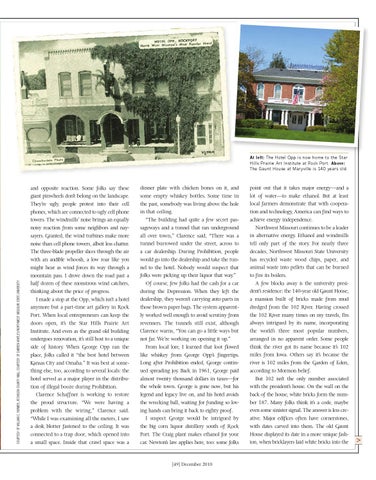COURTESY OF WILLIAM C. FARMER, ATCHISON COUNTY MAIL; COURTESY OF DARREN WHITLEY/NORTHWEST MISSOURI STATE UNIVERSITY
At left: The Hotel Opp is now home to the Star Hills Prairie Art Institute at Rock Port. Above: The Gaunt House at Maryville is 140 years old.
and opposite reaction. Some folks say these giant pinwheels don’t belong on the landscape. They’re ugly, people protest into their cell phones, which are connected to ugly cell phone towers. The windmills’ noise brings an equally noisy reaction from some neighbors and naysayers. Granted, the wind turbines make more noise than cell phone towers, albeit less chatter. The three-blade propeller slices through the air with an audible whoosh, a low roar like you might hear as wind forces its way through a mountain pass. I drove down the road past a half dozen of these monstrous wind catchers, thinking about the price of progress. I made a stop at the Opp, which isn’t a hotel anymore but a part-time art gallery in Rock Port. When local entrepreneurs can keep the doors open, it’s the Star Hills Prairie Art Institute. And even as the grand old building undergoes renovation, it’s still host to a unique side of history. When George Opp ran the place, folks called it “the best hotel between Kansas City and Omaha.” It was best at something else, too, according to several locals: the hotel served as a major player in the distribution of illegal booze during Prohibition. Clarence Schaffner is working to restore the proud structure. “We were having a problem with the wiring,” Clarence said. “While I was examining all the meters, I saw a desk blotter fastened to the ceiling. It was connected to a trap door, which opened into a small space. Inside that crawl space was a
dinner plate with chicken bones on it, and some empty whiskey bottles. Some time in the past, somebody was living above the hole in that ceiling. “The building had quite a few secret passageways and a tunnel that ran underground all over town,” Clarence said, “There was a tunnel burrowed under the street, across to a car dealership. During Prohibition, people would go into the dealership and take the tunnel to the hotel. Nobody would suspect that folks were picking up their liquor that way.” Of course, few folks had the cash for a car during the Depression. When they left the dealership, they weren’t carrying auto parts in those brown paper bags. The system apparently worked well enough to avoid scrutiny from revenuers. The tunnels still exist, although Clarence warns, “You can go a little ways but not far. We’re working on opening it up.” From local lore, I learned that loot flowed like whiskey from George Opp’s fingertips. Long after Prohibition ended, George continued spreading joy. Back in 1961, George paid almost twenty thousand dollars in taxes—for the whole town. George is gone now, but his legend and legacy live on, and his hotel avoids the wrecking ball, waiting for funding so loving hands can bring it back to eighty proof. I suspect George would be intrigued by the big corn liquor distillery south of Rock Port. The Craig plant makes ethanol for your car. Newton’s law applies here, too: some folks
point out that it takes major energy—and a lot of water—to make ethanol. But at least local farmers demonstrate that with cooperation and technology, America can find ways to achieve energy independence. Northwest Missouri continues to be a leader in alternative energy. Ethanol and windmills tell only part of the story. For nearly three decades, Northwest Missouri State University has recycled waste wood chips, paper, and animal waste into pellets that can be burned to fire its boilers. A few blocks away is the university president’s residence: the 140-year old Gaunt House, a mansion built of bricks made from mud dredged from the 102 River. Having crossed the 102 River many times on my travels, I’m always intrigued by its name, incorporating the world’s three most popular numbers, arranged in no apparent order. Some people think the river got its name because it’s 102 miles from Iowa. Others say it’s because the river is 102 miles from the Garden of Eden, according to Mormon belief. But 102 isn’t the only number associated with the president’s house. On the wall on the back of the house, white bricks form the number 187. Many folks think it’s a code, maybe even some sinister signal. The answer is less creative. Major edifices often have cornerstones, with dates carved into them. The old Gaunt House displayed its date in a more unique fashion, when bricklayers laid white bricks into the
[49] December 2010
KING 49
10/31/10 3:02:54 PM
